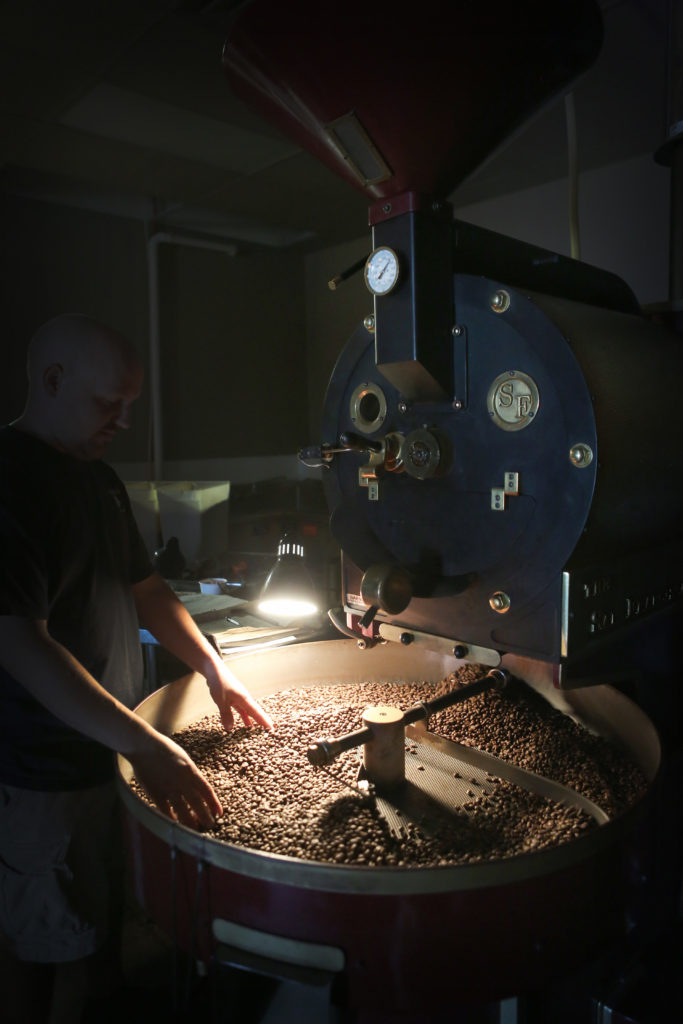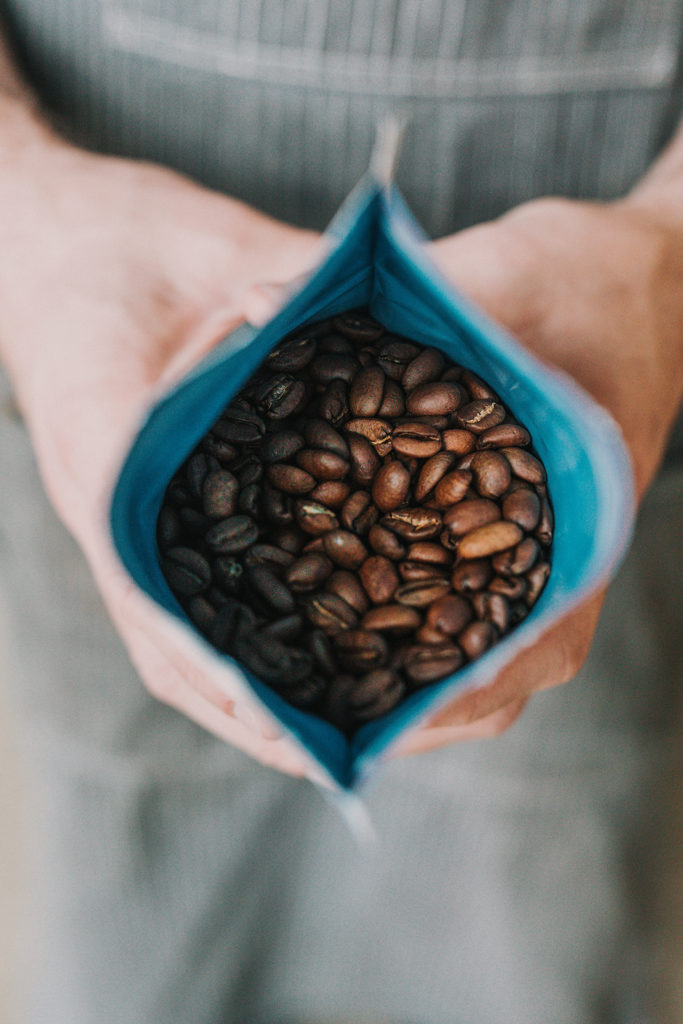Craft Coffee
Capanna Roasting

Experience the difference, expect the best. Capanna is dedicated to the freshest cup by roasting our coffees in each store. Read below to learn more about the adventure of coffee roasting!
Why is roasting so important?
Although bean storage, water, brewing and temperature are important- the most dramatic effect the bean undergoes is the roasting process. Green coffee beans remain stable to the environment for months, but once roasted, coffee characteristics become extremely sensitive to their surroundings. Even if great care is taken during storage, the freshness of coffee cannot last more than a couple of weeks. Since Capanna roasts on the premises we can ensure the freshest roast. This greatly affects the whole beans you buy and the drinks you purchase. Capanna is proud to be providing the freshest coffee possible.
Roasting (the process)

The Experience of Coffee Roasting: Roasting is a beautiful blend of science and art. In simple terms the beans must be heated in a continuous motion to roast evenly, then rapidly cooled to room temperature at the right moment. This sounds easy enough, but an endless number of hours have been spent by roastmasters crafting many different types of roasts and coffee blends. Coffee roasting is a lifelong roasting process, but here is a small glimpse of the process:
Roasting is pretty quick , generally 12 to 15 minutes per batch.
Green coffee is loaded into the roaster by an opening on the top called the hopper. The roasting chamber is preheated and the roasting begins its process. The chamber temperature drops because of the beans temperature. The temperature becomes fairly stable and the beans warm up during this phase. The flames are then turned up to begin the roasting! Knowledge of each bean crop comes in at this point since each country, region by region, have distinctive characteristics.
Now as the temperature rises the roastmaster must watch tiny changes as they take place with the beans. The roaster can see the beans through a small window and with a tiny device that can bring samples out at any point. The beans now change from their grayish green color to a light brown. At this point the beans also begin to expand, letting off a little smoke. The time and temperature are of essence and this is the point where the beans reach their “first crack” or pop. Now we enter the final stage of the roasting process. The temperature in the roasting drum is held steady. During the next few minutes the characteristics of the taste and aroma are created. Tracking the time, holding the temperature and watching the beans are crucial at this point. The beans are brown to dark brown with oils developing on the surface of the bean. As the beans begin a second pop, the process is coming to an end. Once the roastmaster finishes determining the color and oil level of the beans are where they should be, the front door of the roasting drum is opened and the beans are brought into a cooling pan to reach room temperature as quickly as possible. The roast is done and ready to enjoy cupping!
Coffee & Health

We have all questioned the effects of coffee consumption. Studies are being done on coffee and its relation to heart disease, diabetes and other issues. At Capanna, we are passionate about coffee in every way and support the research of these health related concerns. Here is a little information we have found along with some helpful links to continue exploring the complexities of our favorite beverage!
Caffeine: Caffeine is found in over 60 plant species of which the most well-known are cocoa-beans, tea and coffee. An 8 ounce cup of freshly roasted and brewed coffee contains 85 mg of caffeine, a single shot of espresso contains 45 – 75 mg, there are 45 mg in a can of Coca-Cola and 80 mg in a chocolate bar. Caffeine works by blocking receptors for a substance called adenosine, which promotes sleep and increases throughout the day, keeping you alert and energized.
Antioxidants: Coffee is one of the richest sources of antioxidants, substances that block the damage to cells that can be caused by reactive oxygen atoms. Methylpyridinium (see figure to the right), an antioxidant that is found exclusively in roasted coffee, is believed to prevent cancer.
Diabetes: Other substances found exclusively in roasted coffee are quinides. These appear to improve the liver’s ability to metabolize glucose, which could keep blood-sugar levels even and prevent diabetes.
Heart Disease: The opinions of health professionals on coffee in relation to heart disease have changed dramatically in the past few years. Here are a few articles including recent studies.
Coffee Cupping

Cupping is a method of systematically evaluating the aroma and taste of coffee beans. It is also used by growers, roasters and buyers to assess the quality of the coffee sample. Proper cupping requires the adherence to an exact set of brewing standards and a formal step-by-step evaluating process. A trained cupper generally looks at six characteristics:
Fragrance: the small of the beans after grinding
Aroma: the smell of the ground-up beans after being steeped in water
Taste: the flavor of the coffee
Nose: the vapors released by the coffee in the mouth
Aftertaste: the vapors and flavors that remain after swallowing
Body: the feel of the coffee in the mouth
Storing | Brewing | Drinking
Storing
To discover the best possible method of storing our beans, we have listened to expert roasters and scientists who suggest the following: Place your freshly roasted whole bean coffee in an airtight container. Coffee’s greatest enemies are moisture and oxygen. Place it out of direct sunlight in a cool dry place.
We highly suggest buying only what you will consume over a couple of weeks.
If you do buy in large quantities, you can place your extra poundage in a Ziploc bag so that no air or moisture can enter, and place it in the freezer. You will have to let each portion thaw completely before grinding, as frozen beans will not grind evenly resulting in a poor brew and compromised quality of taste. Never store your coffee beans in the refrigerator. Coffee beans are very susceptible to odors and the condensation that can form at refrigerator temperatures. Even airtight containers will not keep condensation from forming on the beans and destroying their freshness.

Brewing
Many websites, books and articles have been written on brewing coffee. Each source varies slightly on how to reach the ultimate goal – a perfect cup! Although we emphasize that your own taste preference is what matters, there are three things to consider:
Freshness of the roasted bean
Freshness of the grind
Freshness of the water
The following are guidelines to help you use the best possible methods to create an excellent cup of coffee.
Clean Equipment! The best way to clean your equipment is with baking soda and water. If the last brew you made hasn’t been cleaned out, the sediment can absorb odors and oils that will spoil your next brew.
Excellent Water. Start with cold filtered water. Avoid softened or distilled water which leave out minerals and create “flat” characteristics in taste.
Proper Temperature. Whether you use an electronic brewing system or a single cup pour-over, there isn’t much difference in taste. The difference comes from the temperature of the water. The water needs to be 200 degrees when it comes in contact with the grounds and 190 degrees when it is in the cup. Boiling water will ruin a good cup of coffee and also distort your taste buds for a few hours.
Proper Grind. No matter what type of grind you choose, start with whole coffee beans from a small-batch roaster. Grind your beans just prior to brewing. If you have an electronic grinder or a manual grinder: Drip brew= 10 seconds, French press = 8 to 10 seconds, Espresso or cone filter = 30 seconds.
Proper formula. The proper formula always comes down to the taste you prefer. A good starting place is two tablespoons per six ounce cup, then adjust from there. We also suggest you stir your coffee once before you drink it.
Brewing time. Lastly, the correct grind has to go with the correct time. The ideal time for any single brew cup or drip brewer is four minutes. It is hard to reach that exactly so here is a general guideline to remember: one to four minutes for a fine grind, four to eight minutes for drip grind, six to eight minutes for a regular grind. The only exeption is an espresso shot which should run for 20 to 24 seconds.
Drinking
To drink or not to drink? We say drink, but how? In order to begin the process one must acknowledge one’s inner cry for that sweet nectar they call coffee… what? And who are “they”?
“They” are you. And we believe that you should be able to enjoy your coffee any way that you like it. Whether you choose to purchase our freshly roasted beans and brew them at home, or sit in our store with a friend and engage in lively conversation, we believe that you will find your ultimate desire fulflilled: with an excellent cup of coffee.
